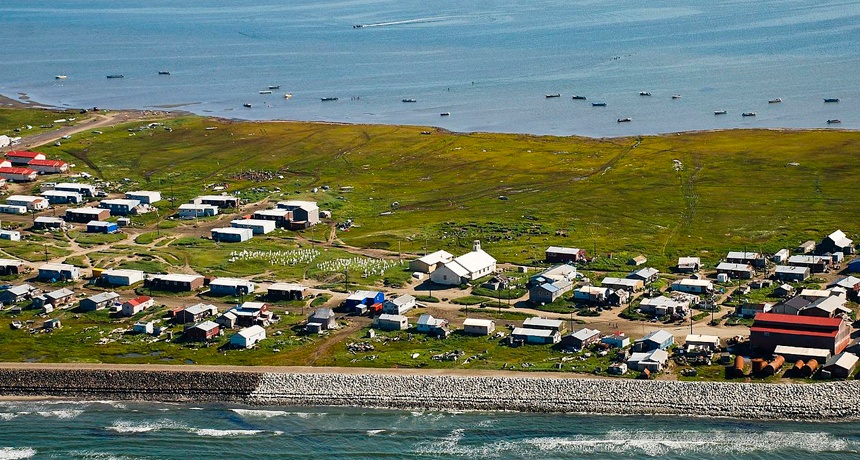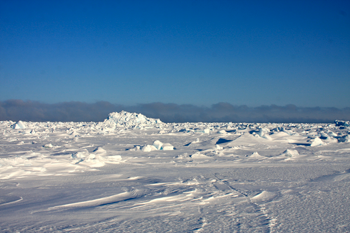Warming turns Alaskan villagers into climate migrants
As disastrous erosion is washing away their island home, the people of Shishmaref vote to move

The village of Shishmaref, Alaska, sits on a low-lying island that is rapidly losing ground.
Bering Land Bridge National Preserve/Wikimedia Commons (CC-BY 2.0)
The village of Shishmaref sits along the edge of an island sitting above Alaska’s north coast. Although about 6.4 kilometers (4 miles) long, in some places the island is less than an eighth of a kilometer wide. And its Inupiat residents are worried. In recent years, their island home has been losing ground due to coastal erosion. Some houses in this community of 563 people already have fallen into the water. In August, the villagers decided they’d had enough. They voted to abandon their island home rather than try to continue guarding it from further land loss.
Scott Rupp works at the University of Alaska in Fairbanks. There he studies the Arctic environment. “Coastal erosion is a normal process that happens all around the world anywhere that water and land meet,” he explains. “What’s changed is the rate and magnitude of that erosion. It really has been accelerating,” he says. “And that,” he adds, “has turned into a significant problem for places like Shishmaref.”

What’s happening to this village is similar to what happens when waves hit a sand castle. The foundation crumbles. What’s on top then begins to tumble into the sea. The warming due to climate change has sped up this process in the Arctic. That has expanded the destruction of Shishmaref.
“What’s been changing over the last couple of decades is that Alaska is warming faster than the rest of [the United States],” Rupp explains. Climate change has increased summer and winter temperatures in Alaska. This warms the land and sea, making coastal towns especially vulnerable to storms.
Why? With all of the warming, “We’re seeing really dramatic changes in sea ice,” says Rupp. He’s referring to the ice that typically covers much of the Arctic Ocean.
Each autumn, along the north coast of Alaska, the ocean begins to freeze. This creates a solid structure that protects coastal soils from being battered by incoming waves and washing away during winter storms.
But with warming temperatures, that ice is not forming as quickly and as solidly as it used to, Rupp notes. So destructive waves have been chewing up and flooding Shishmaref’s coastline. The result, more and more of the land has been washing away.
The warming also has been melting the region’s permafrost. This is the soil that usually stays frozen yearround in northern Alaska. For millennia, that permafrost had provided a “very stable foundation” for the island, Rupp explains. Now it’s softening. So the village is no longer on solid ground.
Not surprisingly, winter storms here are having a much bigger impact than they used to.
“I was born in 1997, and since then, Shishmaref has lost about 100 feet [of ground],” Esau Sinnok wrote in a 2015 blog post for the U.S. Department of the Interior. Sinnok lives on the island and says 13 of its homes had to be moved because of erosion. They included his grandmother’s.
Other villages also weighing a move
Shishmaref’s plight is not unique. Other villages in Alaska also are losing real estate as their coastlines wash away. These include Newtok, Kivalina and Shaktoolik, notes Sally Russell Cox. Working for the Alaska state government in Anchorage, she helps coastal communities respond to the impacts of climate change. These villages, Cox notes, “have all been looking at the option of relocation for a long time.”
Like Shishmaref, Newtok decided that moving is its best option. Kivalina is weighing whether to become a climate migrant as well. But not Shaktoolik. Says Cox, its residents want to stay “and defend where they are.”
“The longer these decisions are delayed, the harder and more expensive it gets to figure out what comes next,” says Philip Loring. He studies environment, climate change and the cultures of native peoples, such as the Inupiat. He works at the University of Saskatchewan in Saskatoon, Canada.
Deciding to move is an especially difficult decision for communities — like Shishmaref — that depend on local fishing and hunting for food. Explains Loring, their families have lived in the same place for generations. Their land also is central to their culture and traditions. These factors are important both to adults and to young people, he notes.
Cox agrees. Youth in these communities have gotten involved in decision-making on whether to move or try to stay put, she says. After all, she points out, “They are the future leaders.”
“While it’s too late to save the island of Shishmaref, we still have a little bit of hope that we’ll be able to preserve our traditions and stay united as a culture,” wrote Esau Sinnok. Next for Shishmaref is planning when to move — and how to pay for it.







